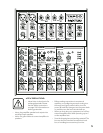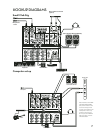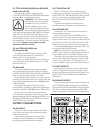
4
GETTING STARTED
The following steps will help you set up your mixer, and get the levels
and adjustments just right.
ZERO THE CONTROLS:
1. Leave the POWER cord disconnected from the
MIX Series mixer.
2. Turn down the channel strip GAIN, AUX SEND,
and LEVEL controls.
3. Center the channel strip EQ and PAN/BAL
controls.
4. Turn down the MASTER AUX SEND and CTRL
ROOM/PHONES controls.
5. Leave all switches out (up).
6. Turn down the MAIN MIX control.
CONNECTIONS:
1. Connect your speakers to your amplifi er’s outputs
(unless, of course, you have powered speakers).
3. Using TR or TRS cables, make connections from
your mixer’s MAIN OUT to your amplifi cation
system’s line inputs.
4. Connect your microphones and instruments to
the mixer: Connect microphones to the mono
channel MIC INPUT jacks. (For condenser
microphones, engage the PHANTOM POWER
switch — not available on the Mix.50.) Connect
line-level signal sources to the LINE input jacks.
Note: Normally, you would plug in only one
microphone or one instrument into each mono
channel.
5. Zero the controls, as described above.
6. Connect the power cord supplied with your mixer
to the POWER connection on the back and plug
it into an AC outlet properly confi gured for your
model.
7. Plug all other sound system components into
suitable AC outlets, properly grounded and
capable of delivering adequate current.
8. Turn all the power switches on, leaving the
speaker’s amplifi er’s switch for last.
Note: There is no power switch on the MIX Series
mixers. They are powered up as soon as they are
plugged in to an AC outlet.
9. Turn up the MAIN MIX control to the 9 o’clock
position (for the Mix.50 and Mix.60) or to the –10
mark (for the Mix.100 and Mix.120), for now.
We’ll crank it up later on.
10.
Now you are ready to set the levels.
SET THE LEVELS (Mic/Line Channels):
1. Choose one of the microphones or instruments
you connected to the mono MIC or LINE input.
Make some noise. If it’s a microphone, sing at your
normal singing volume. If it’s an instrument, play it
at its normal output level.
2. While making noise, turn up that channel’s GAIN
until the PEAK LED (next to the PAN control)
starts blinking.
3. Raise that channel’s LEVEL to unity gain (U label).
You should be hearing your noise now.
4. If necessary, apply channel EQ changes. (You may
need to compensate for level changes afterward
with the channel LEVEL control.)
5. Repeat steps 1 through 4 for the other Mic/Line
channel(s).
6. Stop making noise. Everyone: start making music.
7. Now turn up the MAIN MIX control to a
comfortable listening level.
SET THE LEVELS (Stereo Line Channels):
1. Make some noise with the mono or stereo
instrument connected to the LINE IN jacks on a
stereo line-input channel.
2. Adjust the line-input signal level at the source until
the PEAK LED (next to the PAN control) starts
blinking.
Note: The Mix.50 does not have PEAK LEDs on
its two stereo channels. In that case, set the input
signal to its normal operating level, but listen
for any signs of distortion. If the signal sounds
distorted (and not on purpose!), then turn down
the input signal at the source.
3. Raise that channel’s LEVEL control until
it is approximately equal in volume to the
microphones or instruments connected to
channels 1 and 2.
4. If necessary, apply channel EQ changes. (You may
need to compensate for level changes afterward
with the channel LEVEL control.)
5. Repeat steps 1 through 4 for the remaining stereo
channels.


















